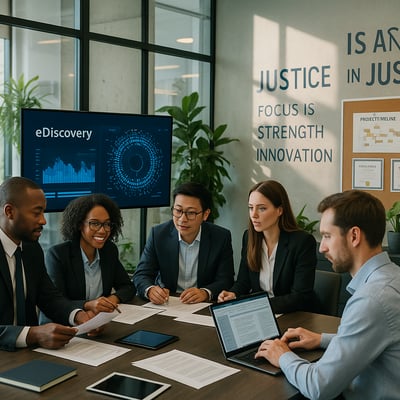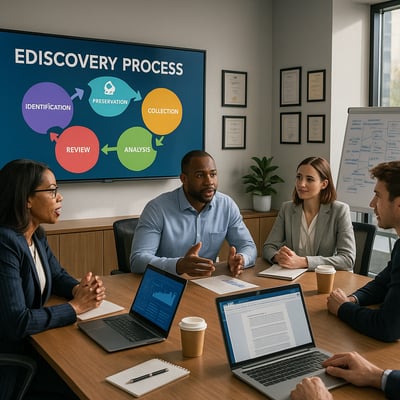" Cut Through the Digital Clutter: Why eDiscovery Is No Longer Optional \n In today’s legal...

Every week, the Array team reviews the latest news and analysis about the evolving field of eDiscovery to bring you the topics and trends you need to know. This week’s post covers the period of August 26-September 1. Here’s what’s happening.
Too many attorneys experience this headache: During discovery, their team inadvertently produced information that should be privileged. Fortunately, there are rules that allow counsel to “claw back” those documents.
But there’s a lot of nuance in how those rules are applied.
FTC vs. Amazon, Inc. is a good example. Kelly Twigger explores another angle to the case in her latest “Case of the Week” post at eDiscovery Assistant. (You might remember our previous post on the case.)
Amazon tried to claw back several privileged documents it said were inadvertently produced as part of FTC investigations. Using Federal Rules of Evidence 502(b) as the standard, the court considered whether Amazon had made reasonable efforts to fix its production error.
Specifically, Amazon had to meet three tests:
According to the court, Amazon failed the first test in regard to one memo. The document was produced multiple times with redactions, indicating that Amazon knew it was intentionally sharing the memo. Although the court found that Amazon’s production process was reasonable when it came to checking for privilege, the company failed the last test for some of the documents. It had taken 18, 21 and 49 days to try and claw them back, and it didn’t show why those delays were reasonable.
(It wasn’t a total loss for Amazon. The court agreed to perform an in-camera review of two documents where the company didn’t waive privilege.)
As Twigger notes, even in a case involving a massive number of documents, parties still have to follow the rules. The key is to have a plan for thoroughly searching for and identifying privileged documents early. Communicating with everyone on your team and having one person in charge of these details could help you avoid ending up in this situation.
Another point to note: The two sides had agreed to use Rule 502(d) for litigation, which states that — under order by a federal court — disclosing a document in connection with litigation pending before the court doesn’t mean privilege or protection is being waived. As part of that, disclosure also wouldn’t waive privilege in other federal or state proceedings. But the court found that it only applied to the litigation, not the discovery that occurred during the FTC’s investigations. That’s why the court used 502(b) as its standard.
The distinction between 502(b) and 502(d) can be critical. Doug Austin wrote about a relevant case on eDiscovery Today.
In Edgar v. Teva A Pharm. Indus., Ltd., the defense wanted to apply 502(d) and allow clawback for any privileged information, even if production wasn’t a mistake. The defense argued that using that standard would prevent disputes over whether a disclosure was inadvertent. The plaintiff opposed that proposal, preferring 502(b) and its three tests instead. Making it easier to claw back could allow the other side to remove documents already produced in other courts.
Ultimately, the magistrate judge agreed with the defense. If one side abuses the ability to claw back, she wrote, the other can challenge whether those documents are privileged.
When two sides disagree over discovery protocol, the need to show cooperation and transparency could be the deciding factor. That’s another takeaway from Edgar v. Teva.
The plaintiff wanted the defense to use technology-assisted review (TAR) only after it had made a good-faith effort to produce documents using a set of agreed-upon search terms. The plaintiff said it didn’t oppose TAR but wanted the defense to disclose why it needs TAR and then “enter into a cooperative and transparent TAR protocol.”
The defense pushed back, arguing the plaintiff’s plan would raise the cost and time required for discovery. Using search terms would be a mostly manual process. And it wouldn’t necessarily be more accurate than TAR. The defense also argued against a request for a “transparent” protocol, which it considered ambiguous. Disclosing why TAR is needed might force the defense to waive attorney-client privilege or work product.
The magistrate judge sided with the plaintiff. Both parties made valid arguments, she wrote, but the plaintiff cited several persuasive cases that emphasized the need for cooperation and transparency when producing electronically stored information (ESI). The judge didn’t entirely dismiss the defense’s concerns over cost and time, though. The demand for manual production really could diminish the benefits of TAR. She noted that what counts as a “good faith” effort in this situation wasn’t clear, and the two sides couldn’t agree on a definition even after she had informally asked them to do so. Ultimately, she said, any protocol would need to be reasonable, too.
When you negotiate an ESI protocol with an opposing counsel, it can help to have an eDiscovery specialist on your team. That partner can help craft a policy that meets the burden of production while protecting your client’s interests. Or if necessary, provide insights that could be useful if a disagreement goes before a judge.
Other recent eDiscovery news and headlines:
With a decade of expertise, Julia excels at optimizing enterprise eDiscovery workflows from start to finish. With a deep understanding of how to seamlessly integrate workflows across various eDiscovery platforms, Julia creates tailored solutions for data identification, legal holds, ESI collections, and productions. By harnessing the power of Technology Assisted Review and Analytics, she delivers efficient, cost-effective results that align with best practices and budgetary constraints. Julia’s exceptional communication and customer service skills have fostered strong, lasting relationships with both clients and Project Management teams, enabling her to effectively problem-solve and drive success across numerous projects.

" Cut Through the Digital Clutter: Why eDiscovery Is No Longer Optional \n In today’s legal...



Every week, the Array team reviews the latest news and analysis about the evolving field of...